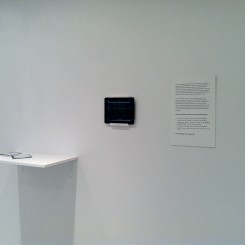In Search of Social Media Art
In a detailed description of the show “Virtual Voices: Approaching Social Media and Art” in Vancouver, Jennifer Hall writes about the works of Chinese artists Remon Wang, Ge Fei, Lin Zhen, Zhang Lehua, and Lu Yang. She also introduces the age of social media art and the censored internet environment of China it has stemmed from, in hopes of a strong beginning for this progressive and important new art form.
“Virtual Voices: Approaching Social Media and Art” explores issues associated with the expansion and censorship of social media in modern life in China. The resulting collection of works is a heady cocktail of artistic stealth and political subterfuge.
The messages of most of the art works in “Virtual Voices” are restrained, perhaps a little too subtle for audiences in Vancouver to grasp given the cultural context of the art — the exception being Remon Wang’s political cartoons. His colourful, eye-catching, comedic digital illustrations poke fun at official government responses to corrupt individuals, environmental issues and family tragedies.
Wang’s works are openly critical of authority and as a result, can only be viewed online. An official, public exhibition would be virtually impossible, therefore, social media (via his Weibo accounts until they are found and blocked by censors) is his prime channel of distribution.
But, does Wang’s work constitute “social media art”?
The broad definition of social media art (SMA) is evolving, but generally it is accepted that SMA includes some online audience involvement and the development of social relationships. For example, an artist initiates a concept, launches it onto a social media platform and then tracks and documents the progress of the online responses.
In an article published in Yishu’s May/June issue, An Xiao Mina, an American new media artist who has worked in China, in conversation with “Virtual Voices” curator Diana Freundl, noted that “social media art has a different character in China” (p.102) and that few Chinese artists and institutions have embraced the inclusion of audience participation in their art practice.
One of the exhibited art works that fits the above definition of SMA is the Youth Apartment Exchange Program, a project by the Beijing-based collective, Forget Art. Using Weibo (the Chinese version of Twitter), participants can arrange to temporarily swap homes. Online, then offline, relationships are developed and the participants are then asked to document their experiences online.
This project quietly comments on the strict controls that regulate where Chinese citizens can live. Unfortunately, documentation of the participants’ virtual voices is missing. Snippets of online conversations (translated into English) and analysis (the dissent, the boredom, the disgust, the distrust and the delight) would draw the non-participating gallery visitor into a deeper understanding of the uniqueness of Chinese contemporary life and art.
Ge Fei and Lin Zhen’s project involved commissioning a band to create several songs which they later distributed copyright-free via Chinese online music sharing platforms. While in Vancouver, the artists used similar platforms and social media (including Twitter, Facebook and other blogs banned in China) to share their music with online and offline audiences. But again the documentation of the interactive relationships was limited — making the social media event less accessible for non-participating observers.
More text was needed to outline the social outcome of the online art event. Future exhibitions of SMA may require the art world to soften its reluctance to document and interpret art with words. If there is a reason to include more text on the walls of the white cube, it is the need for additional commentary about Chinese social media art — especially if the work is being viewed by Western audiences.
Zhang Lehua addresses the reality of social media in China with a satirical commentary “Facebook Art Demo,” a video about the production of an official government-sanctioned Facebook.
The instructor demonstrates how to create a Facebook page, starting with the slow application of lipstick. While reciting the text of a poem, he bends and kisses a page of a traditional folding scroll. Then, he elegantly brushes ink around the lipstick in a wide circle — in lonely isolation, he repeats the kiss and brushwork on each consecutive page. The end result is a bound, not wired or wireless, book of faceless faces. At its surface the video is hilarious but the inner message points at the continuing pressures on Chinese netizens to maintain anonymity.
Also commenting on social media rather than using it as a medium, Lu Yang’s work, which includes skeletons hooked up with cyber wires, is also about power and control. Ironically, her work questions the potential advances of artificial intelligence and the worrying outcome if humans lose control of Web 3.0; technological advances that go beyond the clever applications of social media. Instead of directly criticizing the way in which humans try to control each other, Lu’s work comments of the worrying outcome if artificial intelligence is left unchecked to self-evolve and take control of humanity.
This brave exhibition is one of the first of its kind; it breaks new ground and also establishes an important base-line of artistic responses by Chinese artists to social media, and ultimately China’s current censorship issues. A similar exhibition in five years will be an extraordinary witness of political progress (hopefully).
“Virtual Voices: Approaching Social Media and Art in China,” group exhibition.
Charles H. Scott Gallery (Emily Carr University of Art and Design, 1399 Johnston Street, Vancouver, BC, Canada). June 6 – July 8, 2012.
